Scottish Study of Early Learning and Childcare: ELC Leavers (Phase 2) Report - Updated 2021
Findings from the second phase of the Scottish Study of Early Learning and Childcare (SSELC), a research project established to evaluate the expansion of early learning and childcare (ELC) in Scotland.
This document is part of a collection
Use of ELC
Formal ELC provision
Both the parent and the keyworker questionnaires asked about funding for the child's ELC provision. The parent questionnaire asked whether all of the child's time at the setting was paid for, and the keyworker questionnaire collected more detailed information about registered hours which were funded through their statutory entitlement, through discretionary funding from their local authority and self-funded, as well as actual hours attended. Analysis in this section (and subsequent sections on child health and development and parent outcomes) is based on weighted data.
Almost three-quarters (72%) of parents / carers reported that all of the time the child spent at the setting was funded through their statutory entitlement. Apparent differences by income and area deprivation were not statistically significant. However, when the respondent (generally the mother) was in paid employment, they were more likely to report having to pay for some of the time (34%, compared with 11% of those not in employment. See Table C1 in Appendix C).
The vast majority (89%) of parents took their full allocation of statutory funding[20] at one setting. On average, children were registered for 15.6 funded hours each week, rising to 18.6 when unfunded hours were included. Eleven percent were registered for fewer than 15 funded hours per week and 9% for more than 16.25 hours[21]. Including unfunded hours, 29% of children were registered for more than 16.25 hours, including 8% who were registered for 30 hours or more. Parents not in work had a slightly higher average number of funded hours than those in work (16.7 compared with 15.3) perhaps reflecting the additional discretionary funding that some local authorities may provide for children and families in greater need. The reverse was true for total hours, with an average of 17.2 total registered hours for children of parents who are not in work, compared with 19.4 hours where the parent (mother) is in work.
Additional childcare
In the parent survey, nearly half (47%) of parents[22] reported using at least one other provider of childcare (including both formal childcare from other nurseries or childminders and informal, such as from grandparents) in addition to the nursery at which their child was registered for participation in the survey. Table 1 shows data from the parent and child surveys combined, and hence figures differ slightly from those produced from parent data alone. This shows that only one fifth (19%) of parents used multiple settings for formal childcare. Much more common was use of a single formal setting, in some cases topped up with informal childcare. Four fifths (81%) of parents used a single setting. In half of these cases (41% of all cases) the only childcare received was the funded childcare. In the other half of these cases, this was topped up with either additional unfunded childcare at the same setting (16% of all cases), informal childcare (20% of all cases), or both (5% of all cases).
| All | |
|---|---|
| % | |
| Funded formal ELC only - single setting | 41 |
| Funded formal ELC only - multiple settings | 1 |
| Funded and unfunded formal ELC - single setting | 16 |
| Funded formal ELC - single setting + informal | 20 |
| Funded formal ELC - multiple settings + informal | 1 |
| Funded and unfunded - single setting + informal | 5 |
| Funded and unfunded formal ELC only - multiple settings | 7 |
| Funded and unfunded formal ELC - multiple settings + informal | 10 |
| Unweighted base | 884 |
Base: All respondents (for whom valid data was provided on hours of childcare in both keyworker and parent survey, weighted)
Figure 2 shows the average hours of childcare provided each week for the three main combinations identified: funded ELC in a single setting only; both funded and unfunded ELC in a single setting; and funded ELC in a single setting topped up with informal childcare, as well as for all children[23]. On average this shows that children are in childcare for around 27 hours a week, comprising 17 hours of funded formal ELC, 5 hours of unfunded formal ELC, and 5 hours of informal childcare. The overall figures, however, mask the reality for most families that either they receive the funded ELC only, averaging around 17 hours per week, or that they top this up with either unfunded childcare at the same setting, to an average of 30 hours a week, or informal childcare, to an average of 32 hours a week.
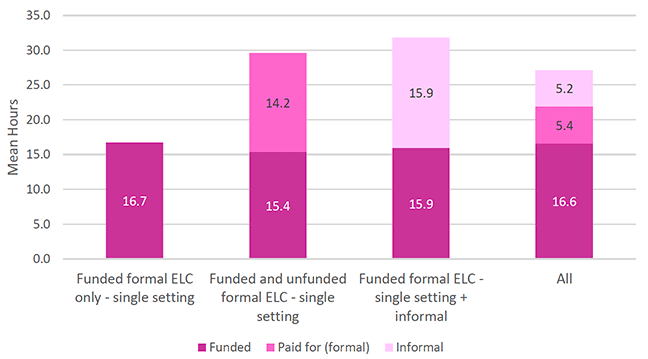
Base: All respondents (for whom valid data was provided on hours of childcare in both keyworker and parent survey, weighted)
Returning to data from the parent questionnaire, as shown in Figure 3, the use of additional childcare (from a provider other than the one where the questionnaire was handed out) was more common among couple parents (50%) than single parents (37%). It also increased as levels of deprivation decreased, from 37% in the most deprived areas to 57% in the least deprived.
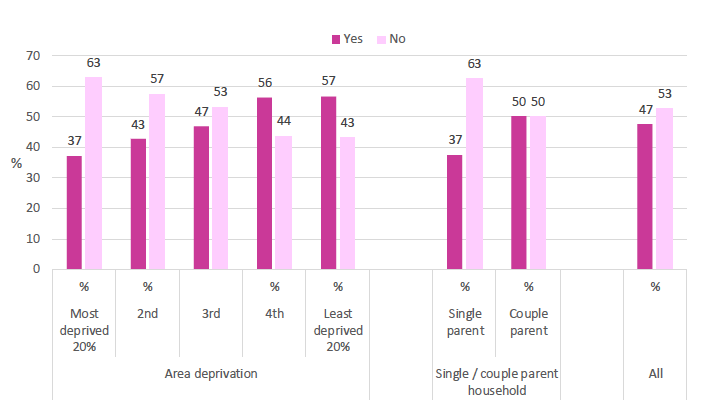
Base: All respondents (parent survey, weighted)
Table 2 shows the proportions of parents using each of the different types of childcare they were asked about. While 55% of parents did not use any childcare other than the ELC provision already discussed[24], 29% used one additional type of childcare and 17% used two or more additional types. A third of parents (33%) mentioned using grandparents to look after their child. This represents around three-quarters of those who used any form of childcare in addition to the provision previously discussed. Much smaller proportions used other forms of childcare, the largest of which were childminder (10%), private or workplace nurseries (6%) and other relatives (i.e. other than grandparents, 5%). Grandparents were much more commonly used by those in work than those not in work (42% compared with 7%). The use of grandparents for childcare was also associated with decreasing levels of area deprivation, rising from 24% of parents in the most deprived areas to 44% in the least deprived. The pattern for income was slightly less clear; 16% of parents in the lowest income quintile reported using grandparents, rising to 50% of those in the second highest quintile, and then falling to 39% of those in the highest income quintile (see Table C2 in Appendix C). Those in two-parent households were more likely to take advantage of grandparents for childcare than those in single-parent households (37% and 16% respectively).
| All | |
|---|---|
| % | |
| None of the below | 55 |
| Grandparents | 33 |
| Childminder | 10 |
| Private or workplace crèche, nursery, playgroup or pre-school | 6 |
| Another relative | 5 |
| Local Authority crèche, nursery, playgroup or pre-school | 3 |
| Ex-spouse or partner | 3 |
| Friend or neighbour | 2 |
| Nanny or babysitter | 1 |
| Community or voluntary crèche, nursery, playgroup or pre-school | 1 |
| Other person | 0 |
| Unweighted base | 1,373 |
Base: All respondents (parent survey, weighted)
On average, parents reported an additional 8.6 hours of childcare a week outside of the nursery where the child was registered for participation in the survey, 0.9 hours of which were funded. Among only those who used additional childcare, the mean number of additional hours was 19.1.
Following on from the childcare questions, parents were asked how they felt about the amount of support / help they got with childcare from family or friends outside their household. Two-thirds (69%) said they got enough support, while 12% said they did not get enough, 11% did not get any at all, and 8% said they did not need any support. There were no significant differences in these figures by area deprivation or household type.
Previous use of childcare
Parents were also asked about types of childcare their child received before the age of three. Most children had been in at least one form of childcare before reaching that age[25]. Of those families that had used childcare, more than half (56%) had used grandparents, and a third (33%) had used a private or workplace nursery or crèche. As shown in Table 3, smaller proportions had used other types of nursery (local authority,11%; voluntary, 6%) or other individuals (including childminder, 15%; ex-partner, 9%; and other relatives, 16%).
| All | |
|---|---|
| % | |
| Grandparents | 56 |
| Private or workplace crèche, nursery, playgroup or pre-school | 33 |
| Another relative | 16 |
| Childminder | 15 |
| Local authority crèche, nursery, playgroup or pre-school | 11 |
| Ex-spouse or partner | 9 |
| Community or voluntary crèche, nursery, playgroup or pre-school | 6 |
| Friend or neighbour | 5 |
| Nanny or babysitter | 2 |
| Other | 7 |
| Unweighted base | 1,223 |
Base: All respondents who reported using childcare prior to age 3 (parent survey, weighted)
As with current use of grandparents for childcare, couple parents were more likely to have used grandparents in the early years (61% compared with 37% of single parents). There was also an increase in the use of grandparents as income increased across the first four income groups, from 39% to 67%, followed by a fall in use amongst parents in the highest group to 48%. The use of private nurseries prior to the age of three was more common amongst families in more advantaged circumstances. For example, 52% of parents living in the least deprived areas reported having used this type of provider before the child was aged 3 compared with 19% of those living in the most deprived areas. Similarly, 53% of parents in the highest income households had used this type of provision for the child compared with 18% of those in the lowest income group (See Table C3 in Appendix C). These patterns were reversed for the use of local authority nurseries, falling from 18% to 5% with decreasing levels of area deprivation and from 19% to 6% with increasing levels of income. This may be connected to the use of local authority nurseries for funded provision for eligible 2-year-olds. The nature of this offer, with eligibility based on receipt of certain benefits, makes it more common in more deprived areas.
Engagement with ELC setting
Parents were asked whether they had done any of a range of eleven activities at their child's setting since the previous August (the start of the school / nursery year). A number of these focused on engagement with the child and the nursery staff, such as attending a parents' evening or information event, or offering to help out in the nursery. Others focused on some of the wider support that some ELC settings are able to offer to parents, such as help with welfare rights or learning a new skill.
As shown in Figure 4, all but a few parents (> 99%) had participated in at least one of the activities, with nearly all having visited their child's room (93%) and discussed their child's progress with her or his keyworker or another member of staff (97%). Large proportions had also attended a parents' evening or information event (86%) or another type of nursery event (82%). More than half had stayed and played with their child (58%) or had talked to someone about how to support their child's learning at home (56%). Just under half had helped out, or offered to help out in the nursery, including on a trip or with a nursery event (43%). Much smaller proportions had learned a new skill such as cooking or parenting skills (7%), received help with welfare rights or issues with benefits (3%), received help with food or clothing (3%), or received help with transport to the nursery (1%).
It is only among less common activities that there is evidence of variation between different subgroups. For example, 6% of single parents and 7% of those with no formal qualifications or low levels of school education reported receiving help with welfare rights, compared with 1% of couple parents and 1-2% of those with higher levels of education. Similarly, 7% of single parents and 6% of those with no or only low levels of educational qualification reported receiving help with food or clothing, compared with 1% of couple parents and 0-2% of those with higher levels of education. Nineteen percent of those with no formal educational qualifications and 14% of those with only lower levels of qualifications reported learning a new skill, compared with 5-6% of those with higher levels of qualifications. (See Figure 4 and Table C4 in Appendix C).
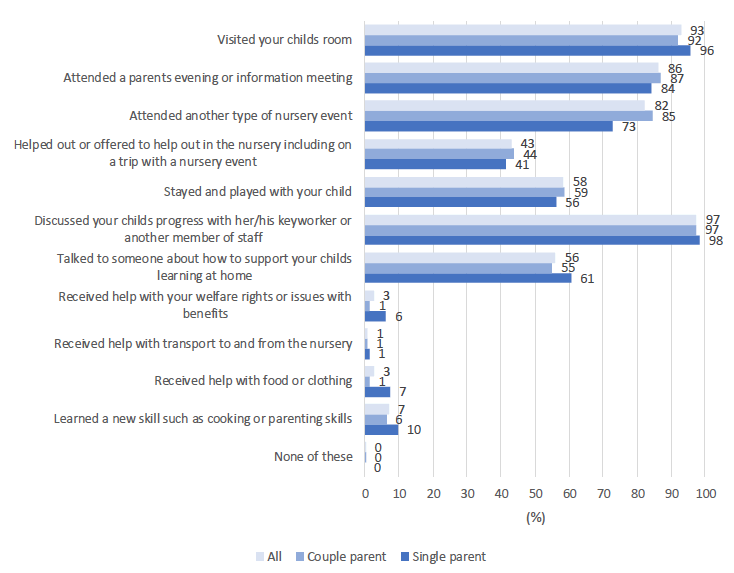
Base: All respondents (parent survey, weighted)
Accessibility, advantages and disadvantages of child being in nursery
More than three-quarters (79%) of parents lived close enough to the ELC setting that a one-way journey took less than 10 minutes[26]. Nearly half (47%) lived within five minutes, and only 3% lived more than 20 minutes away. There were no significant differences by area deprivation. A higher proportion of those living in rural areas or small towns[27] than those living in urban areas lived within five minutes of the nursery (57% compared with 43%. See Table C5 in Appendix C). Single parents were more likely than those in a couple to live more than 20 minutes away (8%, compared with 2%).
| All | |
|---|---|
| % | |
| 0 to 5 minutes | 47 |
| 6 to 10 minutes | 32 |
| 11 to 15 minutes | 13 |
| 16 to 20 minutes | 5 |
| 21 to 30 minutes | 2 |
| More than 30 minutes | 1 |
| Unweighted base | 1,350 |
Base: All respondents (parent survey, weighted)
Parents were asked what were the main advantages and disadvantages of their child attending nursery. The list of potential advantages included advantages for the parent (for example, it enables them to work, study or train) and advantages for the child (for example, it helps their educational development). Similarly, the list of disadvantages included some that concerned the parent (for example, nursery hours are not flexible) and some that concerned the child (for example, child is often unhappy in nursery). In a change from the questions used at Phase 1, the questions were specific to the respondent and their child (rather than parents and children generally), and respondents were asked to tick all responses that applied. The responses are summarised in Figures 5 and 6.
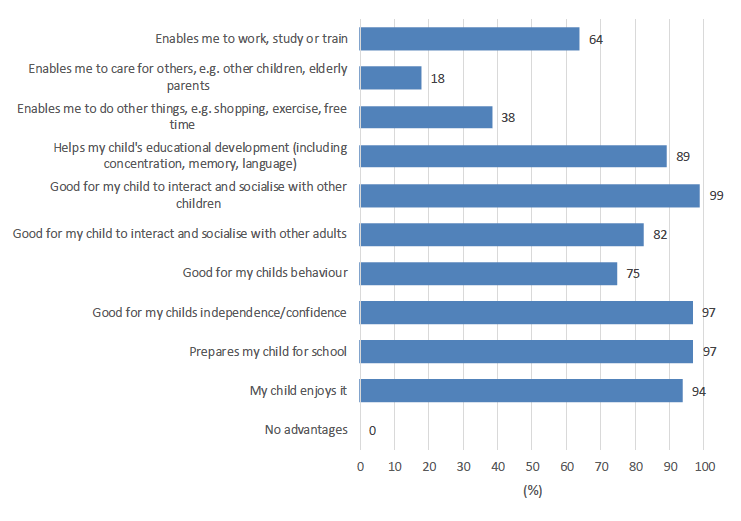
Base: All respondents (parent survey, weighted)
All parents mentioned at least one advantage for themselves or their child, with advantages for the child being more commonly cited than those for the parent. Nearly all parents said that it was good for their child to interact and socialise with other children (99%), that it was good for their independence / confidence (97%), that it prepared them for school (97%) and that they enjoyed it (94%). At least three-quarters also said that it helped their child's educational development (89%), it was good for them to interact and socialise with other adults (82%), and that it was good for their behaviour (75%). Two-thirds (64%) of parents said that having the child in nursery enabled them to work, study or train. Smaller proportions said that it enabled them to care for others (18%) or to do other things (38%).
Two-thirds (64%) of parents said that there were no disadvantages to the child being in nursery. The main disadvantages mentioned were that nursery hours were not flexible (18%), that the child is not in nursery for long enough to allow time for work (17%), and that the child picks up bad habits / behaviour (9%).
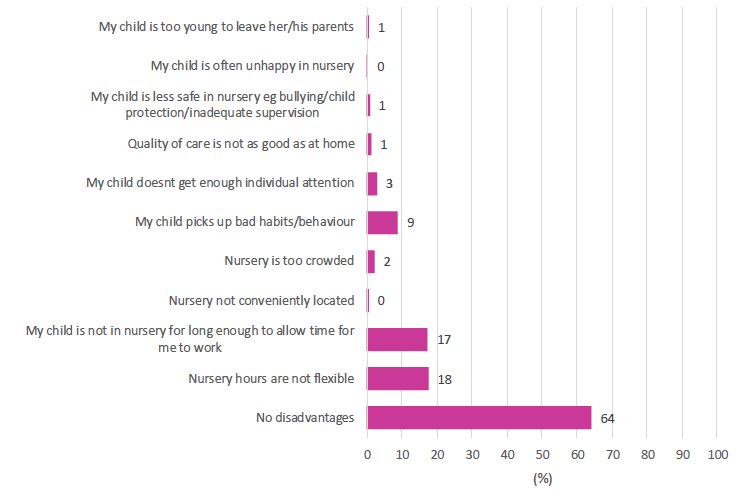
Base: All respondents (parent survey, weighted)
Contact
Email: socialresearch@gov.scot
There is a problem
Thanks for your feedback